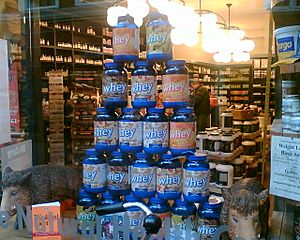Whey protein facts for kids
Whey protein is a mix of proteins that come from whey. Whey is the liquid left over when cheese is made. These proteins include things like alpha-lactalbumin and beta-lactoglobulin. Whey protein is often sold as a protein supplement to help people get more protein. Some people think it has many health benefits. For building muscles, whey protein has been shown to be a bit better than other proteins, like casein or soy.
Contents
How Whey Protein Is Made
Whey is what's left after milk turns solid during cheese making. It contains everything from milk that can dissolve in water, like lactose (a type of sugar) and some fats.
To get whey protein, the whey goes through a process. This process removes the lactose, fats, and other parts that are not protein. One way to do this is using special filters. After filtering, the liquid is often spray-dried to turn it into a powder.
Heat can change whey proteins. If whey is heated too much, like during pasteurization (which makes milk safe to drink), the proteins can change their shape. This can make them clump together and form a gel.
New Ways to Make Whey Protein
Scientists have found ways to make proteins that are like whey protein using tiny living things called microbes. Companies like Perfect Day and California Performance are working on this. These products are similar to other foods made using GMO technology. They aim to create whey protein without needing cows.
What Is Whey Protein Made Of?
The protein in cow's milk is about 20% whey and 80% casein. But in human milk, it's about 60% whey and 40% casein.
The protein part of whey is usually a mix of different proteins. The main ones are beta-lactoglobulin and alpha-lactalbumin. There's also bovine serum albumin and immunoglobulins. Another big part of whey protein is glycomacropeptide, which isn't exactly a protein. All these parts can dissolve in water easily.
Main Types and Uses of Whey Protein
Whey protein from cow's milk usually comes in four main forms:
- Concentrates (WPC) have some fat and cholesterol. They also have more lactose (sugar) compared to other forms. They are usually 29% to 89% protein.
- Isolates (WPI) are processed more to take out the fat and lactose. They are usually 90% or more protein. Like concentrates, they have a mild, slightly milky taste.
- Hydrolysates (WPH) are whey proteins that have been partly broken down. This makes them easier for your body to digest. But they usually cost more. Highly broken-down whey might cause fewer allergic reactions for some people.
- Native whey protein is taken directly from skim milk. It's not a leftover from making cheese. It's made as a concentrate or isolate. This type does not have glycomacropeptide, which forms during cheese making.
Whey protein is often sold as a dietary supplement. You usually buy it as a powder to mix into drinks. It's also used to make many types of yogurt thicker and smoother. Yogurts with lots of protein, like Greek Yogurt, have become very popular.
Whey Protein for Muscles
Many people use whey protein supplements to help their muscles grow and get stronger. Taking whey protein after exercise can help your body recover. It also helps your body make new proteins for your muscles.
In 2010, a group of experts looked at how whey protein affects weight loss and muscle building. They found that there wasn't enough proof to say it helps with weight loss. They also said that whey protein is about as good as other protein sources for building strength and muscles.
Even though some people have milk allergies because of whey proteins, the main things that cause milk allergies are usually the caseins.
Whey Cheese
Whey cheese, like ricotta, is made from whey. These cheeses are rich in whey protein. For example, whey protein makes up about 40–45% of the solid parts of ricotta cheese.
See also
 In Spanish: Proteína de suero de leche para niños
In Spanish: Proteína de suero de leche para niños


